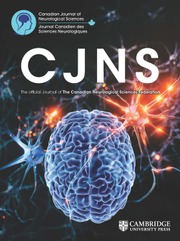Crossref Citations
This article has been cited by the following publications. This list is generated based on data provided by
Crossref.
Clark, Jeffrey G.
Abdullah, Kalil G.
Steinmetz, Michael P.
Benzel, Edward C.
and
Mroz, Thomas E.
2011.
Minimally Invasive versus Open Cervical Foraminotomy: A Systematic Review.
Global Spine Journal,
Vol. 1,
Issue. 1,
p.
009.
Hohl, Justin B.
and
Patel, Alpesh A.
2011.
Posterior Laminoforaminotomy for Cervical Radiculopathy.
Techniques in Orthopaedics,
Vol. 26,
Issue. 3,
p.
131.
Barakat, Mohamed
and
Hussein, Youssef
2012.
Anatomical study of the cervical nerve roots for posterior foraminotomy: cadaveric study.
European Spine Journal,
Vol. 21,
Issue. 7,
p.
1383.
Díaz, Roberto Carlos
Berbeo, Miguel Enrique
Quintero, Silvia Tatiana
Acevedo, Juan Carlos
Zorro, Oscar Fernando
and
Feo, Oscar Hernando
2014.
Craniocervical junction diseases treatment with a minimally invasive approach.
Coluna/Columna,
Vol. 13,
Issue. 2,
p.
129.
Ziewacz, John E.
Wu, Jau-Ching
and
Mummaneni, Praveen V.
2014.
Microendoscopic Cervical Foraminotomy and Discectomy: Are We There Yet?.
World Neurosurgery,
Vol. 81,
Issue. 2,
p.
290.
Lawton, Cort D.
Smith, Zachary A.
Lam, Sandi K.
Habib, Ali
Wong, Ricky H.M.
and
Fessler, Richard G.
2014.
Clinical Outcomes of Microendoscopic Foraminotomy and Decompression in the Cervical Spine.
World Neurosurgery,
Vol. 81,
Issue. 2,
p.
422.
Pazmiño, Pablo R.
and
Lauryssen, Carl
2014.
Minimally Invasive Spine Surgery.
p.
231.
Gerard, Carter S.
and
O’Toole, John E.
2014.
Current Techniques in the Management of Cervical Myelopathy and Radiculopathy.
Neurosurgery Clinics of North America,
Vol. 25,
Issue. 2,
p.
261.
Allen, R. Todd
and
Indresano, Andrew A.
2014.
Minimally Invasive Spine Surgery.
p.
395.
McAnany, Steven J.
Kim, Jun S.
Overley, Samuel C.
Baird, Evan O.
Anderson, Paul A.
and
Qureshi, Sheeraz A.
2015.
A meta-analysis of cervical foraminotomy: open versus minimally-invasive techniques.
The Spine Journal,
Vol. 15,
Issue. 5,
p.
849.
Kim, Chi Heon
Kim, Kyoung-Tae
Chung, Chun Kee
Park, Sung Bae
Yang, Seung Heon
Kim, Sung Mi
and
Sung, Joo-Kyung
2015.
Minimally invasive cervical foraminotomy and diskectomy for laterally located soft disk herniation.
European Spine Journal,
Vol. 24,
Issue. 12,
p.
3005.
Diaz, Roberto
and
Berbeo, Miguel E.
2015.
Surgical Approaches to the Spine.
p.
269.
Kim, Chi Heon
Shin, Kyung-Hyun
Chung, Chun Kee
Park, Sung Bae
and
Kim, Jung Hee
2015.
Changes in Cervical Sagittal Alignment after Single-Level Posterior Percutaneous Endoscopic Cervical Diskectomy.
Global Spine Journal,
Vol. 5,
Issue. 1,
p.
31.
Banczerowski, Péter
Czigléczki, Gábor
Papp, Zoltán
Veres, Róbert
Rappaport, Harry Zvi
and
Vajda, János
2015.
Minimally invasive spine surgery: systematic review.
Neurosurgical Review,
Vol. 38,
Issue. 1,
p.
11.
Riccio, Alexander R.
Entezami, Pouya
Giuffrida, Anthony
Dowling, John
Forrest, George
and
German, John W.
2016.
Minimally Invasive Surgical Management of Thoracic Ossification of the Ligamentum Flavum Associated with X-linked Hypophosphatemia.
World Neurosurgery,
Vol. 94,
Issue. ,
p.
580.e5.
Dodwad, Shah-Jahan M.
Dodwad, Shah-Nawaz M.
Prasarn, Mark L.
Savage, Jason W.
Patel, Alpesh A.
and
Hsu, Wellington K.
2016.
Posterior Cervical Foraminotomy.
Clinical Spine Surgery: A Spine Publication,
Vol. 29,
Issue. 5,
p.
177.
Eicker, Sven Oliver
Steiger, Hans Jakob
and
El-Kathib, Mustafa
2016.
A Transtubular Microsurgical Approach to Treat Lateral Cervical Disc Herniation.
World Neurosurgery,
Vol. 88,
Issue. ,
p.
503.
Oertel, Joachim M.K.
Philipps, Mark
and
Burkhardt, Benedikt W.
2016.
Endoscopic Posterior Cervical Foraminotomy as a Treatment for Osseous Foraminal Stenosis.
World Neurosurgery,
Vol. 91,
Issue. ,
p.
50.
Song, Zhaojun
Zhang, Zhi
Hao, Jie
Shen, Jieliang
Zhou, Nian
Xu, Shengxi
Ni, Weidong
and
Hu, Zhenming
2016.
Microsurgery or open cervical foraminotomy for cervical radiculopathy? A systematic review.
International Orthopaedics,
Vol. 40,
Issue. 6,
p.
1335.
Burkhardt, Benedikt W.
Müller, Simon
and
Oertel, Joachim M.K.
2016.
Influence of Prior Cervical Surgery on Surgical Outcome of Endoscopic Posterior Cervical Foraminotomy for Osseous Foraminal Stenosis.
World Neurosurgery,
Vol. 95,
Issue. ,
p.
14.


